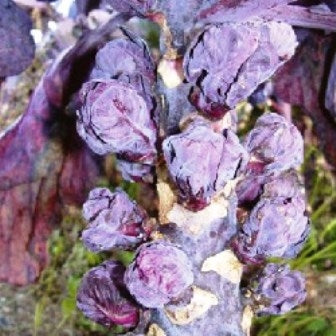RUBY BRUSSELS SPROUTS - ko98
Have a question?

RUBY BRUSSELS SPROUTS - ko98
Dettagli
Scientific name: Brassica oleracea gemmifera
Family: Brassicaceae
Brief history and botanical notes on the plant
Brussels sprouts are the axillary shoots of a variety of the Brassica oleracea cabbage family, Gemmifera. Brussels cabbage belongs to the Cruciferae – Brassicaceae family, tribe: Brassiceae – species Brassica oleracea L..
The plant is native to Belgium and is cultivated mainly in Europe. The main producing nations are England, France and Holland. It seems to have been imported into Italy by the Roman troops occupying Belgian territory.
The plant has an erect stem, up to 1 meter tall, alternate leaves, more or less lobed, round at the apex and long petiolate, slightly blistered and green in colour.
The stem ends with a tuft of floppy ball-shaped leaves. Along the stem other leaves bear shoots in the shape of rounded glomeruli (sprouts) in the axils, 25-30 in number. They are made up of imbricated leaves (one covering one or two underneath, like artichokes). These lumps, harvested when they are the size of a walnut or at most about a chicken egg, constitute the edible parts of the Brussels cabbage.
 Needs
Needs
It grows well in areas characterized by cool, humid summers and mild winters, a climate typical of some areas of northern Europe.
Sowing and transplanting times
Brussels cabbage is produced exclusively in the open field. The cultivation time is between 6 and 8 weeks, the main sowing is carried out between March and mid-May. The seedlings are transplanted when they have reached a height of 20-25 cm, 50 cm apart on the row and rows 60 cm apart, eliminating the seedlings with absent or deformed vegetative apex and the frail ones.
To guarantee early production (August-September), sowing is brought forward by a month.
Processing
Mulching can be helpful.
Fertilization
For its cultivation it is not necessary to use organic fertilizers that are too rich in nitrogen as the small globular heads would lose their characteristic conformation, remaining small and open.
Products
It is intended for fresh consumption.
Cultural care
It is very important to carry out large rotations, to avoid the appearance of adversities, in particular cabbage hernia.
The shape of this plant is reminiscent of Tuscan black cabbage and the cultivation is very similar. It often requires supports to prevent it from bending.
Irrigation
The crop especially requires irrigation upon transplantation and during the glomerular swelling phase.
Adversity
Among the fungal diseases we remember Alternariosis (Alternaria brassicae), Cruciferous hernia (Plasmodiophora brassicae), basal rot (Sclerotinia spp., Rhizoctonia solani, Phoma lingam) and downy mildew (Peronospora brassicae, Peronospora parasitica). Also sensitive to some bacteria (Xanthomonas campestris, Erwinia carotovora).
The most important animal parasites are aphids (Myzus persicae, Brevicoryne brassicae), noctules, cabbage flies (Mamestra brassicae, Mamestra oleracea, Pieris brassicae), wire weevils (Agriotes spp.), altica (Phyllotreta spp.), weevils (Baris spp., Ceuthorrhyncus spp.) and the cabbage fly (Delia radicum).
Defense products
Downy mildew can be prevented by spraying with horsetail decoction.
Hernia of cruciferous plants and numerous basal and bacterial rots are strongly limited by correct rotations (avoid the cultivation of any cruciferous plant for 3-4 years on the same plot), by the distribution of lithotamnium on the soil before transplanting and by spraying with horsetail decoction .
Bacillus thuringiensis and neem oil are used to control night moths and cabbage flies.
Altica can be a serious problem especially in the case of compact and dry soil; it can be contained in small family gardens with broom branches and dusting the vegetation with lithotamnium and bentonite. In case of strong attacks, use pyrethrum.
The control of the cabbage fly is above all preventive and essentially consists in the destruction of vegetation residues, possibly also removing the surrounding earth. Intra-sowing, for example with clover, hinders oviposition.
Production and collection
Production runs from September to March with yields of 1-2 kg/m2. We start from the tufts at the base, when they reach 2-3 cm in diameter. For late varieties you can wait for the first frosts, which improve the quality of the heads.
Brussels sprouts have a bitter and acidic taste: to increase their digestibility it is advisable to boil them for a few minutes in very salted water and then proceed with normal cooking.
Nutritional values
Brussels sprouts provide 30 calories per 100 g and have a good content of iron, phosphorus, potassium, calcium, vitamin C, vitamin A and fibre. Like all vegetables belonging to the Brassica oleracea genus, Brussels sprouts have an anti-ulcer, anti-anemic and detoxifying action (once upon a time it was common to administer the cooking water from the leaves to get rid of severe inebriation). The indoles, dithiolthiones, vitamin E, vitamin C, chlorophyll, flavonoids and phenolic acids present in this culture are considered useful in the prevention of various neoplasms. In particular, consumption is recommended for women because, by acting positively towards the metabolism of hormones, it helps prevent breast cancer.
Family and variety
Brussels cabbage includes numerous varieties that adapt to different seasons and climates.
Early varieties (production from late September to November): Early half dwarf, Asgard, Cor, Lunet, Mallard, Nicoline, Porter, Riga.
Semi-late varieties (production from November to December): Citadelle, Héraclès, Kundry, Odessa, Pilar, Rampart, Tornado, Perfection.
Late and very late varieties (production from January to March): Content, Edmund, Stat, Gabion, Igor, Lauris, Pinacle
Biodynamics
In addition to the spraying of spray preparations at the plant and in production, the supply of well-composted organic substance via biodynamic heap allows you to limit imbalances in growth and the consequent attacks of parasites and allows the sprouts to develop well, reaching the right size without them opening.
It is advisable to weed the propagation material with soil mixed with cornoletame 500 or with diluted biodynamic log paste.
USE OF THE BIODYNAMIC CALENDAR
Sow on leaf days and to preserve quality and shelf life, harvest on leaf days.


